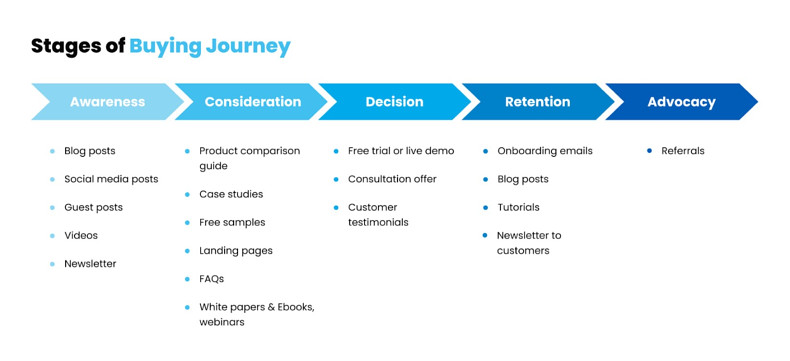Effective Content Writing in 15 Steps
Table of Contents
NEW! Listen to article
Great content creates brand awareness and brand visibility; plus, it grows a loyal audience that knows and likes your brand. Ultimately, it can help you increase sales.
How?
B2B buyers consume, on average, 13 pieces of content before making a decision to reach out to a salesperson or buy a product. That’s why a content marketing strategy is so important: It makes future customers aware of your business and more likely to purchase from you.
What Is Effective Content Writing?
Sales aren’t the only way to measure effective content marketing. There are various metrics and goals to achieve with content, depending on the stage of your buyer’s journey.
The following is a visual representation of how to measure success at each stage.

You can set certain goals as part of your content writing strategy at each stage:

If you have an increase in traffic, audience, leads, and sales, congratulations! Your content writing strategy is working.
“The most important ingredient to make your content writing successful is focusing on your target audience throughout the whole process of content creation,” says Julian Tavalin, a content marketing professional who focuses on content writing for tech companies. “Know their pain points, challenges, key search terms, and interests. While writing, always put yourself in your target audience’s shoes and help them get answers to their most important questions.”
Brian Dean, a founder of the popular Backlink SEO blog, writes, “As an entrepreneur, one of the best things you can do is just keep trying stuff and messing up and learning lessons.”
Keeping those principles in mind, here are 15 tips for approaching content writing.
15 Step-by-Step Tips for Effective Content Writing
1. Know your buyer persona
You should know exactly whom you are creating your content for. Prepare a description of your buyer’s persona to help you stay on track.
Every buyer persona description should cover the following items:
- Demographics
- Professional status
- Psychographics
- Influences and information sources
- Pain points and challenges
- Purchasing process
Knowing your buyer is the first—and arguably the most important—step in the content creation process.
2. Generate content ideas
If you’re looking for content inspiration…
- Consider what unique expertise you can share with your target audience. That can be best-practices, professional tips from a project, a list of tools that you’ve tried and compared, or an analysis of anything else you’ve worked on recently.
- Check out what your competitors are writing about.
- Get insight from your sales reps to find out what questions your customers ask and what challenges they face.
- Know what questions your target audience asks online. Buzzsumo can help you discover trending topics and questions, which can help you come up with new ideas. Use Quora or Reddit to see what questions related to your chosen topic are popular there.
- Brainstorm ideas with your team. More heads are usually better than one.
3. Choose a content type
Once you’ve compiled your ideas, think about what type of content you want to create. Keep in mind that content is not just about writing an article; different types of content work at different stages of the buyer’s journey.

4. Conduct keyword research
Once you have your ideas ready and you’ve chosen the content type you wish to create, it is important to make sure your chosen idea is a question that your target audience often asks.
Use Ahrefs, SEMrush Magic Keyword Tool, or Neil Patel’s Ubersuggest Google Chrome extension to find out which keywords have the highest monthly search volume.
It’s also crucial to take keyword difficulty into account. Easy and medium-difficulty keywords will give you more chances to end up in the Top 10 on Google.
5. Create a content marketing plan
The last step before starting to actually write your content is to create a detailed content marketing plan. It should contain all your ideas, content types, and keywords researched for those ideas. You’ll fill in more detailed information later.
6. Write a compelling title
Create a title that will make the value of your content clear. The title should ideally contain your main keyword and provide a clear understanding of what your content is about. It should be around 60 characters, or 8-15 words.
Keep in mind that 60 characters is the optimum length of a meta title, which is used by Google bots. However, the article’s actual title should be similar to the SEO title. Titles with specific clarification—containing words such as “guide,” “interview,” etc.—perform 38% better than titles without clarification, according to HubSpot research.
7. Structure your content appropriately
Your content should be clearly structured so that it can be understood by your audience, as well as by search engines. Your blog post or article should ideally contain the following elements: introduction, body text, and conclusion.
Start with the text body and add the rest later. Use subheaders, bullets, and numbered lists to separate the key parts of the post. Add useful images, infographics, and videos. Bold the text that you consider important, but don’t overdo it; only one sentence per paragraph or per several paragraphs should contain bold text.
8. Include storytelling
Tell a story with each piece of content.
DON’T MISS IT… APRIL 6-7, 2022! MarketingProfs B2B Forum Online. Learn from the brightest minds in B2B marketing!
Why is storytelling so important? It helps create an emotional connection between your content and your audience. While telling a story, it is easier to reflect the pain points, challenges, and goals of your audience.
Just as in a book, include main characters, conflict, and a resolution at the end. Your characters are your buyer personas, so write about their challenges and goals. To give emotional appeal to your characters, include conflict that shows your characters’ problems, needs, or fears.
Last, provide a resolution to help your audience to come to a conclusion and solve their problems. Including a call to action (CTA) is a great way to resolve your story.
9. Optimize your content for SEO
Once you have a first draft ready, provide a meta description for your post. A meta description is an HTML element that provides a brief summary of a webpage. It should be 150-160 characters, including your keywords.
Also, create an SEO page title for your post. It can be slightly different from your real title and should be 50-60 characters.
Your meta description and SEO page title will not be visible in your content on the website, but they will be shown to users while searching Google.
10. Include CTAs
CTAs help to direct your audience members to the right action after they consume your content. It can be a “contact us” form to connect with the sales team, a newsletter subscription form, a link to the next article in a series, a form to download a guide, or anything else that encourages them to move to the next stage in the buyer’s journey.
You can add your CTAs at the top of your post, in the text body near the relevant content, or at the end of a post. The CTA should be easy to spot and it should include a clear description of what the reader should do.
11. Edit and proofread your content
Having an extra set of eyes on your content is incredibly important. You may not have followed editorial guidelines when you were focused on the creative process. Plus, you may have misspelled technical terms or miswritten abbreviations.
Proofreading is especially important for leaders at tech companies who are focused more on building high tech solutions than checking grammar or spelling.
12. Make your writing visually appealing
The content should look appealing to you and your audience. Include white space between paragraphs and create original charts, images, and infographics with unique data to support or prove your arguments.
13. Serve your content to the right audience
When your content is ready, you’ll want to publish it on your own website or as a guest post. That will help with some of your promotion needs right away, as you start to receive organic visitors interested in the topic.
You should also share the content on social networks; Twitter, Facebook, LinkedIn, Instagram, and others will help you find more people interested in your content.
Other ways to get your content in front of the right eyes:
• Share the newly created content with newsletter subscribers interested in that particular topic. For example, this AEM Tech Tips Newsletter from Exadel is targeted only toward Adobe Experience Manager practitioners and developers and shares practical AEM content.
• Consider content syndication. Content syndication is a process of republishing your original content on other websites with a link to the original source. You can republish your content to Medium.com, Inc.com, etc.
• Share your content with members of social communities. Compile a list of targeted groups on LinkedIn, Facebook, and Reddit, and share content that is appealing to the audience in those groups. Make sure that when sharing a new article or video, you are not promoting your services. Otherwise, you may be banned and deleted from the group.
• Use paid promotional options to stay on your target audience’s radar. You can use Google display or remarketing ads, Facebook or LinkedIn brand awareness, or lead generation ads—or you can consider working with a popular industry influencer
Your audience isn’t a monolith; some of them may like to receive email updates, others prefer social media, and still others choose to search for content via Google. So, the more channels you use to promote your content, the more people will find your content.
14. Package your content
If you already have a content series dedicated to a specific topic, package it to newsletters and pillar pages. A newsletter will help your audience stay connected to your brand, whereas pillar pages give a comprehensive overview of a topic and will drive better SEO results for your website.
Also, offer well-researched long-read guides, e-books, or whitepapers people can take home with them and read carefully when they have time. That content can be packaged into a gated offer so it’s available for download after submitting a form.
15. Measure and analyze the results of your content
Congratulations, you’ve created effective content! Now it’s time to measure and analyze the results.
Analyze the number of new users, the number of conversions, and bounce rate (the percentage of website visitors who enter the site and then leave without viewing other pages), plus average session duration and source. Use Semrush to analyze your keyword performance and see what content appears in the Top 10 on Google.
If you share your content with newsletter subscribers, track your email open rate, click rate, and the number of unsubscribes.
When reposting your content to social media channels, analyze reach (the number of unique people who saw the post), impressions (the number of times the post was viewed), engagement (number of likes, shares, comments), clickthrough rate (percentage of people who clicked the link on a post), and changes in number of follower.
Analyzing your results is a good practice in content marketing because it helps you understand what content is more appealing to your audience, which will in turn help you decide what to create.
* * *
Follow the tips in this article to make sure your content is effective. Above all, focus on your target audience throughout the journey of content creation. You’ll grow brand awareness, a loyal audience, and sales.
More Resources on Effective Content Writing
Struggling to Write Effective Whitepapers? Here Are Five Steps for Planning One
A 17-Step Process for Creating High-Performing Articles [Infographic]
Making the Boring Interesting: Perk Up Your Writing | MarketingProfs Webinar








